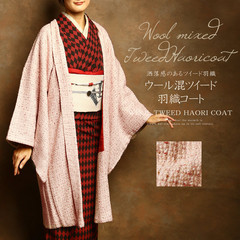THE HAORI 羽織, A "KIMONO" JACKET WITH 1000 FACES
- TABITABIYA
- May 26, 2022
- 4 min read

We’ve said it again and again. After having conquered the hearts of Japanese women of yesterday and today, the haori has now crossed borders to win the hearts of many women around the world, even beyond the private circles of kimono fans! I myself, when on the hunt for bargains at second-hand kimono shops, have to fight the urge to buy dozens and dozens of them!!!! I would buy them all if only I could!
This garment has so many qualities! Let's take a closer look at this iconic kimono jacket that is now internationally celebrated as a must-have fashion item!

Cut in the same way, the haori 羽織 shares with the kimono the same sumptuous fabrics and patterns. But contrary to the kimono, there is no need to cross it in the front or tie an obi to keep it closed. Its two front panels are held in place without touching each other by the use of strings called haori-imo 羽織紐. They are braided in the same materials as the obijime that is tied on the obi sash. This space deliberately left free between the two front panels of the haori is like a window open to the subtleties of the kimono fabric and its obi sash that is decorated with an objime and obiage… A real feast for the eye indeed!

The haori-imo 羽織紐 are also very decorative and are divided into 3 large groups: those sewn to the haori and made of the same fabric as the body of the garment, those that are attached to the haori by a fabric loop system , as in the photo below, or by S-shaped metal buckles (photo below).


You have, today, a whole bunch of other types of haori-imo 羽織紐 and other super fashionable kinds of new designs to tie your jacket. Japanese designers are such creative minds! This brand new design is so easy-to-use as there is no need to tie the strings together. The haori himo are held together by the use of a magnet!

It is also considered best to change your haori himo sometimes to better match your haori 羽織 with the overall feel created by the kimono and the obi sash. The most experienced kimono fans make their own haori himo.
A light jacket that will fall on your thighs or on your knees for the longer ones (the nagabaori 長羽織 or hon-baori 本羽織), the haori 羽織 is worn over a kimono from the first chills of autumn until spring. But for countries other than Japan, it's the perfect alternative to our spring, summer and fall jackets. Especially when you know that Japan is second to none at interpreting the seasons with its beautiful patterns and exquisite art of colour.

Here are all the variations in which this kimono jacket is available:
First of all, you will find the nagabaori 長羽織 or hon-baori 本羽織, guardian of the original shape of this Japanese garment and which fall below your knees, the chubaori 中羽織, as in the photo above, which fall on your thighs or hips. They can be lined 袷羽織 awasebaori, not lined hitoebaori 単衣羽織 or very light for summer with natsubaori 夏羽織, to keep the same transparency effect as for summer kimono. Finally, the chabaori 茶羽織り that we hardly see today except on a yukata 浴衣 in ryokan 旅館 or for certain bodies of workers. They come in simple colors and fabrics for truly everyday use. But make no mistake! They can be quite expensive! In the 1960s, with the fashion for knitting spreading to Japan, there were even woolen ones! And we find them super cute! They are still produced, in a sober and much more modern style, as well as lace haori.
The first two types of haori 羽織, the nagabaori 長羽織 or hon-baori 本羽織, and the chubaori 中羽織 will offer us another world of wonders that calls on the whole universe of textile weaving and dyeing art that have made Japan's tradition and fame:
1) 紋付黒羽織 montsukikurobaori black haori with crest or kurobaori 黒羽織 without crest:
As we told you in our previous blog post, it is the most formal of all haori jackets. It can sometimes feature patterns on the back.
2) 色無地の紋付羽織 iromujimontsukibaori haori in plain color with crest:
Another very popular haori, along with the plain black haori, for temple visits, entrance or graduation ceremonies, etc. because they will not overpower, by their patterns, the overall effect created by the kimono and the obi. On the contrary, they will enhance it.
3) 絵羽織 ebaori which feature a “絵 (é)” pattern meaning “drawing” This haori maintains a luxury image perfect for parties and other outings to the theater or else, etc...
4) And you have the komonnobaori 小紋の羽織, which have the same pattern on their entire surface:
5) the tsumugibaori 紬羽織 which pay homage to the weaving and dyeing technique of the same name, the shiboribaori 絞り羽織:

6) the bokashibaori 暈し羽織, which we love:
etc…. So much beauty to enjoy! You too can choose your haori 羽織 and see how to style it in our next post! You can find all our haori jackets here: https://www.tabitabiya.com/shop
@TABITABIYA

WARNING! No use, copy or other of our texts and images can be made without our prior agreement.



















































Comments